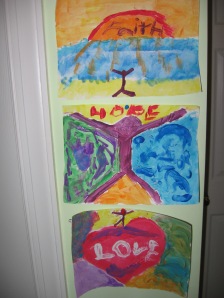
Creating little works of art , coloring in a coloring book, or just surrounding yourself with colors are common ways to practice color therapy.
Below are my notes and a basic explanation of Color Therapy and how it works.
The Science
- Scientists all the way back to Sir Isaac Newton have tried to study color.
- The atom responds to radiation and vibration, allowing for movement. Colors are essentially radiation and sound is vibration.
- Modern psychologists study the way color affects humans on every level, but especially regarding mental health.
- Light=color, Light= Energy, Hence Color=Energy
- Extensive studies have been done throughout the last 200 years on colors and the origin of our preferences.
- The Endocrine system is used to explain the placement of the 7 main chakras in the body at 7 important glands. Each chakra corresponds to the 7 colors thought to be discovered.
- Newton actually only discovered 6 colors but Indigo was added because of his obsession with the number 7. Indigo however has separate energy properties despite the science. Pink also has separate properties as well.
Key Words to research: Color Psychologists, Faber Birren, Dr. Max Luscher, Sir Issac Newton, color experiments.
The Colors
(According to a mixture of Edgar Cayce and Color Psychologists.)
- Each color can be stereotyped to go with any particular group.
- Violet/Purple: The color of artists, royalty/wealth, divine inspiration, introverts, genius, entitlement, temperamental, sensitivity, observant.
- Indigo: Memory, explorers, reasoning, high mental abilities, argumentative, overcautious, communicator. Seeks Harmony, a partner, constant love and affection, and sympathy. A high ego.
- Blue: Spiritual awareness, depth, hard working, unselfish, moody, eccentric, uses own will to obtain goals, desires change and is yet inflexible, self controlled.
- Green: helpful, strong, friendly, growth, healing, passive, social, focused on community, attempting to gain recognition, determination, independence.
- Yellow: Fearful/courageous, sexual, endless energy, creative, powerful, assertive, poignant dreams, contemporary, new ideas, innovation, often rejects unrealistic ideas.
- Orange: Laziness, gregarious, accepting, able to get along with anyone, values friendships, free-loving spirit, no self-doubt, confident, dare-devil, and full of optimism.
- Red: conquest, excitement, vigor, nervous, high temper, impulsive, domineering, desires travel, instability, gluttonous, creative, destructive, fear of conventionality, and emotional.
The Therapy
- Through using mediation and studying how colors affect you in the individual level can help you physically, emotionally, spiritually, and mentally.
- Using the 7 chakras as the basis, one can easily figure out which color is needed depending on the problem. If you have lots of digestive issues, incorporating warm colors into your life would help balance it.
- Gemstones are often used in color therapy due to their heavy energy flows and their particular colors. Meditation on the energies of stones can help you focus on the colors you need, or the colors you have too much of in your system.
- Colors affect moods, especially in one’s environment. Be mindful of the colors you want near you or the colors you want to use around the house.
- You have the power to use color in any way you want! If it takes coloring for an hour or wrapping yourself in a sheet allowing the energy to flow, then do it! Colors are individualized for a reason.
Hope this has been helpful! It should at least get you started on healing yourself.
